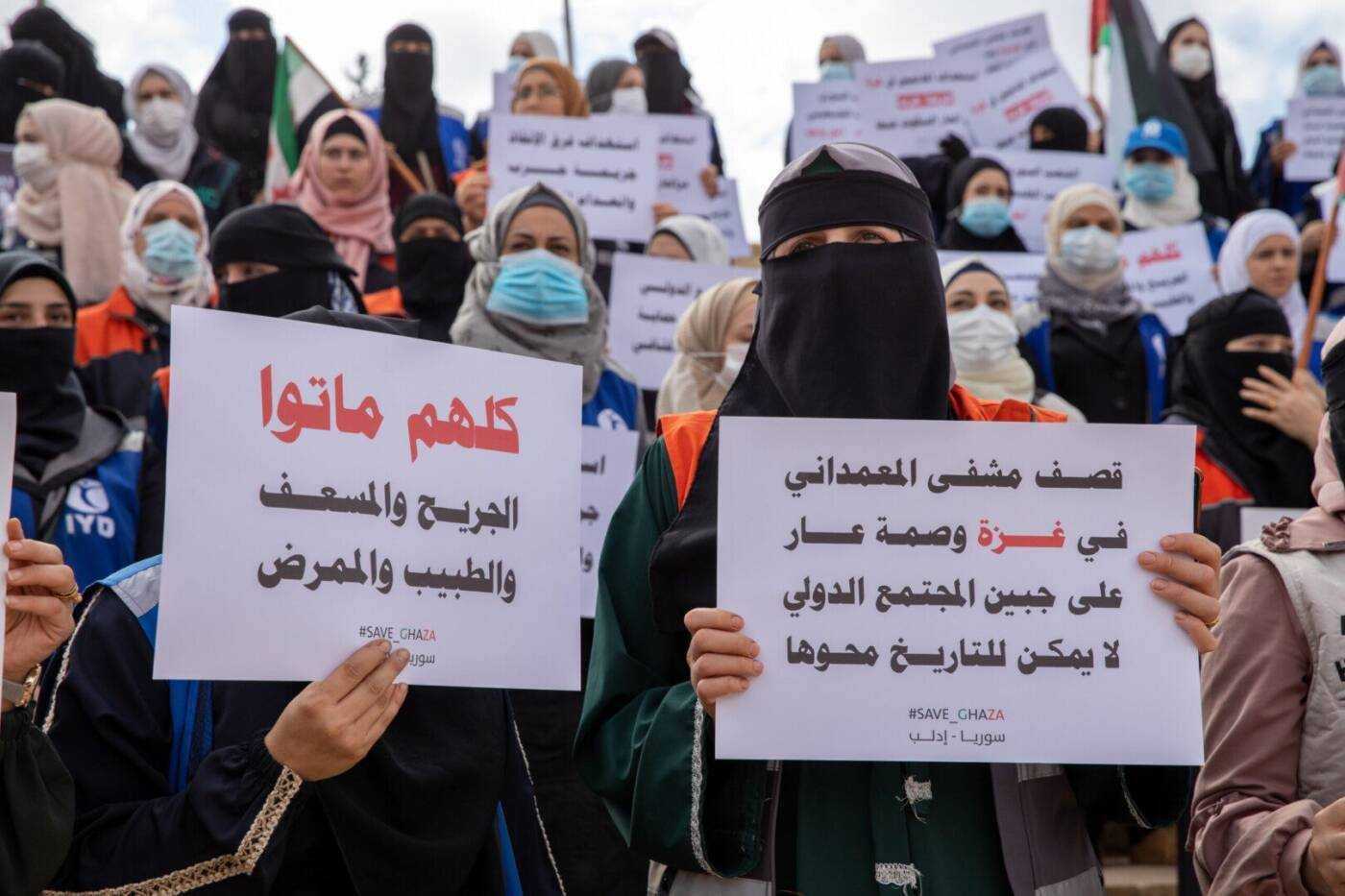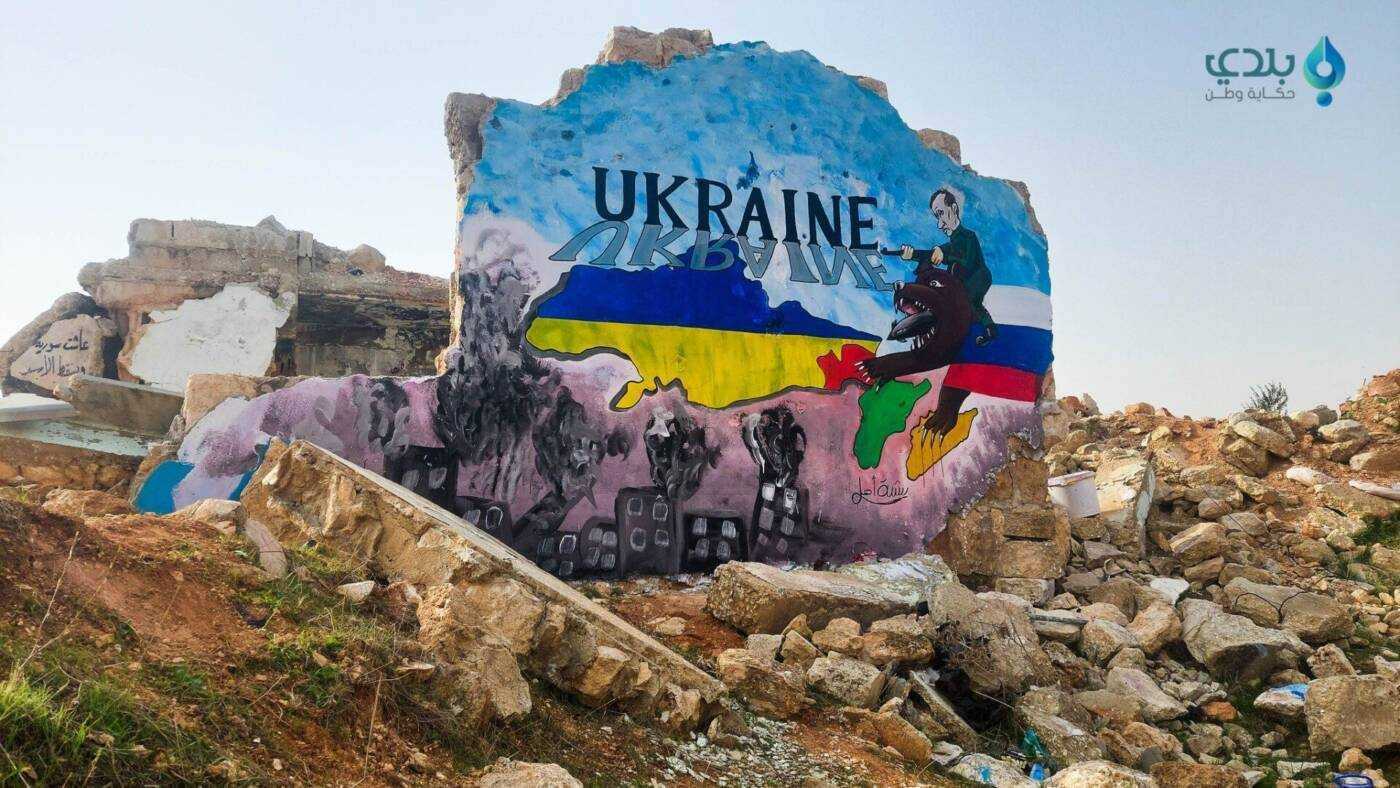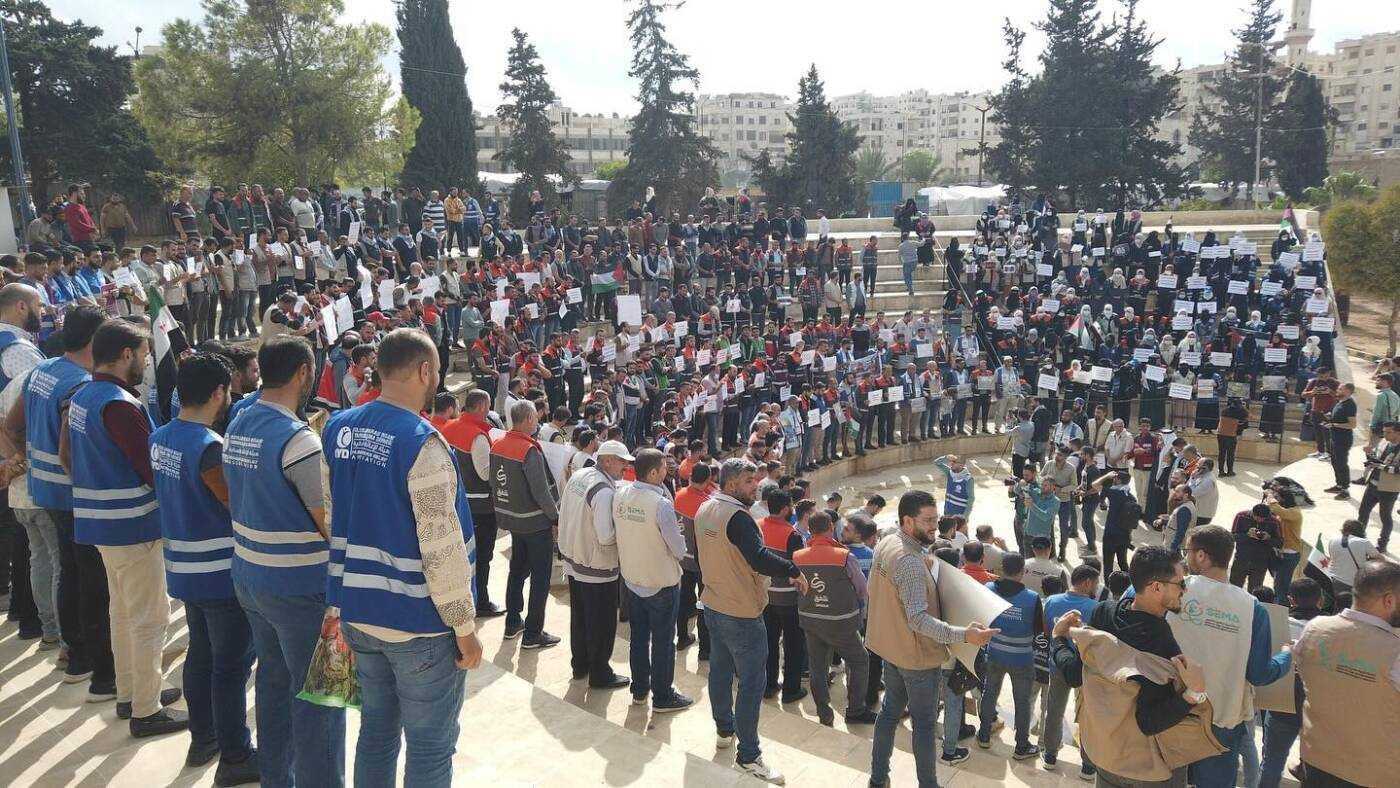From Idlib to Gaza: Syrians demonstrate in solidarity with Palestinians
Residents of Syria’s opposition-held northwest demonstrate in support of Palestinians facing displacement and bombardment in Gaza—an experience many of them share.
21 October 2023
PARIS/IDLIB — In Atma, the largest gathering of internal displacement camps in opposition-held northwestern Syria, Syrians demonstrated in solidarity with Palestinians facing bombardment and displacement in the Gaza Strip last week.
Salwa Abdulrahman, a 50-year-old journalist, was among them. “People here know the meaning of loss. They have lived through moments of fear, bombing, and displacement,” she told Syria Direct. She was not surprised that Syrians in the northwest—especially those displaced from other parts of the country—would demonstrate in support of the people of Gaza.
Northwestern Syria, controlled by opposition forces and Hayat Tahrir al-Sham (HTS), has seen many demonstrations in support of Gaza this month, despite ongoing bombardment by Syrian regime and Russian forces. The latest round of bombardment follows an October 5 drone attack on the regime’s Homs Military Academy that killed at least 89 people.
The Syrian Civil Defense documented 194 attacks against 60 cities and towns in northwestern Syria in the first half of October, killing more than 49 civilians, including 10 women and 13 children. At least 230 people have been injured, including 63 women and 67 children.
“Planes were in Idlib’s skies, and rocket launchers targeted the southern Idlib countryside, but women, youth and men still came together in solidarity with Gaza,” Abdulrahman said. They sent “a message to the world that we stand with Gaza, despite the pain and bombardment we are being subjected to.”
In Darat Izza, a city in the western Aleppo countryside, regime bombardment killed a girl on October 18. The next day, its residents demonstrated to voice support for the people of Gaza and condemn Israeli violations.
‘Not a target’
On October 7, Hamas and other armed Palestinian factions broke out of the Gaza Strip and attacked surrounding Israeli communities, leading to the death of 1,400 people in what it called Operation al-Aqsa Flood.
In response, Israel imposed a total siege on Gaza and launched a devastating bombing campaign, including strikes on infrastructure, residential buildings and medical facilities. As of October 23, the 17th day of bombings, at least 5,087 Palestinians have been killed by Israeli strikes, in addition to more than 15,000 injured, according to Gaza’s health ministry. In the West Bank, at least 90 Palestinians have been killed and 1,772 injured, Palestinian officials say.
On the night of October 17, the al-Ahli Baptist Hospital in Gaza City—where hundreds of displaced civilians were taking shelter—was bombed, killing nearly 500 people, most of them women and children, according to the Gaza Health Ministry. Richard Peeperkorn, the World Health Organization (WHO) Representative for the West Bank and Gaza, called the attack “unprecedented in scale.”
Palestinians say the al-Ahli hospital was hit by an Israeli airstrike. Israel denies bombing the hospital, and claims it was struck by a misfired rocket launched by Palestinian Islamic Jihad. The United Nations has called for an independent investigation into the attack.
Al-Ahli—like 20 other hospitals in the north of the Gaza Strip—had received evacuation orders from the Israeli military before it was struck. During Israel’s ongoing bombardment and siege of Gaza, the WHO has documented damage to 17 hospitals. Some 55 healthcare workers have also been killed, including at least 12 doctors, 14 nurses and 14 paramedics as of October 19.
In the wake of the al-Ahli bombing, staff from humanitarian organizations working in Idlib organized a solidarity demonstration on October 19. They sought to send a message that “humanitarian workers are not a target,” Asma Naasan, 30, who participated in the demonstration, told Syria Direct.
“We lived the [al-Ahli] Baptist Hospital bombing in Gaza dozens of times, when the Syrian regime bombed hospitals,” Abdulrahman said.

Humanitarian workers in Syria’s northwestern Idlib province demonstrate in solidarity with Gaza two days after an explosion at the al-Ahli Baptist Hospital in Gaza City reportedly killed hundreds of people, 19/10/2023 (Abd Almajed Alkarh/Syria Direct)
Naasan, who has worked with civil society and humanitarian organizations since 2015, lives in the northern Idlib city of Dana. She was displaced from her hometown in western Aleppo province in February 2020, due to regime bombardment of the area.
“We, as Syrians in the northwest, are living in poor conditions. Most of us are perhaps unable to provide material support to the people of Gaza,” Naasan said. “What we can offer is our voice, for us to be their voice in communicating their suffering to the world, whether by demonstrating or posting on social media.”
“The regime is bombing us, and targeting our gatherings, yet we came out in solidarity with Gaza. So there is no justification for those who do not show solidarity,” she added. She hopes demonstrating could pressure the international community to “open humanitarian corridors and deliver aid to those who need it in the besieged [Gaza] Strip.”
A humanitarian cause
Many Syrians feel betrayed by Hamas, the ruling power in Gaza and the stated target of Israel’s current scorched-earth operation.
Hamas initially showed support for the Syrian revolution, and left Syria in 2012 as a result, but restored relations with the Assad regime in 2022. The group also has close ties to Iran, currently the Syrian regime’s main ally in suppressing Syrians who took to the country’s streets calling for freedom in the spring of 2011.
But views on Hamas have not impacted Syrians’ sympathy for the Palestinian cause and support for the people of Gaza, multiple sources in Idlib told Syria Direct.
Journalist Abdulrahman said she considered solidarity demonstrations to be “a duty for every person on this planet,” not only Arabs or Muslims.
Naasan felt similarly, and cited Syrians’ support for the people of Ukraine in the face of Russian invasion and aggression. “When Putin invaded Ukraine, we raised the Ukrainian flags in remembrance of our revolution. So it is obvious that we would stand with Palestine in its plight, as it has been our cause since childhood,” she said.

A mural painted by artist Aziz al-Ahmar on a destroyed building in Syria’s northwestern Idlib province in solidarity with Ukraine, 24/2/2023 (Asaad al-Asaad)
Yasser Muhammad (a pseudonym), 35, participated in a solidarity demonstration in Binnish, a city in northeastern Idlib, on October 18. Himself displaced from his hometown of Darayya in Reef Dimashq in August 2016, he went out to express his rejection of “the displacement of the people of Gaza from their homeland,” he said.
Muhammad brought his children with him, to “inform them about what is happening in Gaza at the hands of the [Israeli] occupation, and that these same practices were done to us, but at the hands of another criminal,” he said. “The scenes we see on screen—destruction, bombing, victims—remind us of the massacres we were subjected to.

Demonstrators carry Palestinian flags alongside the Syrian revolution flag at a solidarity demonstration in the Idlib city of Binnish, 18/10/2023 (Abd Almajed Alkarh/Syria Direct)
And in Maarat Misrin, in the northern Idlib countryside, Abdulsalam al-Yousef, who is displaced from the southern Idlib countryside, also demonstrated last week to “convey our voice to the Palestinians in the [Gaza] Strip, [saying] we are with them and with their cause,” he told Syria Direct.
Al-Yousef, who fled his hometown in 2020 due to military operations by the regime and its affiliated militias, also had a warning to convey. “Do not wait for support from the Iranians or the Russians,” he said. “Iran is the one who killed us and displaced us from our homes.”
He referred to Iran’s direct military and political support for the Syrian regime, as well as Iran-linked militias that have participated alongside Damascus in military operations against operation areas across Syria.
Shared suffering
Abu Islam al-Daraawi, 32, tries not to miss a demonstration in support of Gaza. He demonstrated in Dana last week, then in Binnish. “Going out to all the demonstrations is a duty. The people of Gaza’s calamity is our calamity—their wound is our wound. We cannot leave them on their own,” he said.
Al-Daraawi was displaced from southern Syria in the summer of 2018, following a settlement agreement between the regime and factions of the opposition Southern Front. Under the deal, he and others who refused to enter into a settlement left for the opposition-held north.
He is known locally for his voice, repeating revolutionary slogans and chants in dozens of demonstrations. He has done the same in recent solidarity demonstrations for Gaza’s people.
Syrians in Idlib city demonstrate in support of Palestinians in Gaza hours after the al-Ahli Baptist Hospital bombing, 17/10/2023 (Mohamad Khalid)
A shared experience of suffering is what drives al-Daraawi, and many Syrians who have lost loved ones, to stand with Gaza. Syrians have lived “this loss,” Daraawi said. “I know what loss means. In 2015, we were bombed and I lost my brother, who was 35 years old at the time.”
“For 12 years, we have tasted from Assad what you are tasting in Gaza from the occupation,” he said, addressing Palestinians in the besieged area. Al-Daraawi hoped for “relief and patience, for us and for you.”
While people in northwestern Syria are grappling with dire living conditions, journalist Abdulrahman said this does not distract them from humanitarian causes elsewhere, but rather motivates them to participate however they can. “Oppressed people stand up for each other,” she said.
Abdulrahman demonstrated last week not only out of support for human rights, but as a mother, she said. She often thinks about “the heart of a mother” who fears “a shell will fall on her house and tries to have her children in a safe place—who is afraid but tries not to show that to her children.”
“My feelings are the same as a Palestinian mother in Gaza,” Abdulrahman said. She demonstrated in Atma and Idlib with “feelings of motherhood, wishing the world would know mothers’ suffering.” Advocacy is important, she said, “even if only with our voice.”
As Syrians watch unfolding events in Gaza, it is impossible not to draw comparisons with their own experiences. Before Syria Direct spoke with Abdulrahman, she was watching a video of an injured child in Gaza. “He asks the nurse if he will survive,” she said. “This question brought me back to a child in Ghouta, who was injured by the chemical [attack]. She was stunned, asking: ‘Am I alive? Am I alive?’”
“Every scene that reaches us from Gaza takes us back to memories of situations we experienced, or bombardment we were subjected to or could be subjected to,” she added. “We are experiencing the very same scene.”
**
This report was originally published in Arabic and translated into English by Mateo Nelson.







